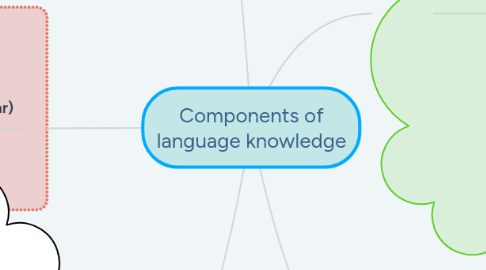
1. • Phonology (sound system)
1.1. Critical Period Hypothesis:
1.1.1. learners past the age of puberty are in all probability unable to achieve native-like pronunciation
1.2. At least intelligible pronunciation is needed for speaking in most educational settings
1.3. Interpersonal competence: intelligible production is essential for successful spoken communication, significant degree of “foreign accent” is acceptable
1.4. Affective purpose or identify socially with the L2 language community: Native or near-native pronunciation
1.5. Transfer from L1 to L2 phonology occurs in perception and production, listening and speaking: phonemes, syllable, Intonation, stress in words and phrases
2. • Syntax (grammar)
2.1. It is the internalization of new construction, order and arrangements of elements, patterns, generative rules, different parameters for innate principles, or collocational probabilities and constraints.
2.2. anguages have structures for making statements, asking questions, and denying assertions
2.3. Sentences: subject and a predicate, and predicates consist of a verb, or a verb and one or two objects, adver phrases of time, place, frequency, manner, goal, source, or purpose. The order of elements may differ radically.
3. • Discourse (ways to connect sentences and organize information)
3.1. Cohesion: sequential indicators, logical connectors, and other devices to create.
3.2. Cohesion devices link one element of discourse to another
3.2.1. They integrate them into a unified text. They include many of the sequential indicators and logical connectors that are listed above, but also such ties as pronominal and lexical reference, substitution, and ellipsis
3.3. Sequential indicators
3.3.1. are linguistic elements that connect phrases, clauses, or longer units of written or spoken text to signal the order in which events take place
3.4. Logical connectors
3.4.1. occur between clauses or other grammatical constituents to indicate such relations between them as cause–effect
3.5. Academic genres
3.5.1. include research papers, lectures, and book reviews; interpersonal genres include conversations, service encounters
3.6. Genres are “conventionalized” categories of discourse
3.7. Contrastive Rhetoric
3.7.1. is an area of research that compares genre-specific conventions in different languages and cultures, with particular focus on predicting and explaining problems in L2 academic and professional writing
3.8. Intercultural Communication:
3.8.1. Transfer of politeness and turn-taking may not interfere with expression and interpretation of the referential content of messages but can contribute to instances of serious misunderstanding of speaker intent and message tone
4. • Vocabulary (lexicon)
4.1. Academic or interpersonal functions.
4.1.1. Academic contexts: modifiers, names for scientific concepts, common scientific and technological terms increasingly tend to be borrowed from one language to another subject-specific terms - concepts with representation.
4.1.2. Interpersonal: primarily affective (interactional) purposes, task-oriented (transactional). common greetings, leave takings, invitations, refusals, and warnings Regional differences idioms, metaphors, collocations greetings and other formulaic routines, and such discourse fillers, hedges, or smoothers
4.2. Types of knowledge contribute to effective use of context for vocabulary learning (Nagy 1997):
4.2.1. •Linguistic knowledge: syntactic information; constraints on possible word meanings; patterns in word structure; meanings of surrounding words.
4.2.2. •World knowledge: understanding of the concepts which the words represent; familiarity with related conceptual frameworks; awareness of social associations.
4.2.3. •Strategic knowledge: control over cognitive resources.
4.3. Function words:
4.3.1. Written: determiners, prepositions, conjunctions, pronouns, auxiliary verbs,
4.3.2. Spoken : interjections, contractions, verbs expressing personal opinion or feeling

